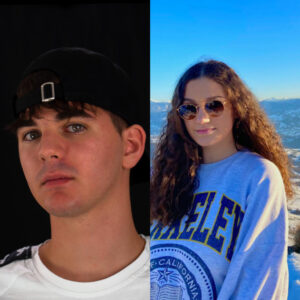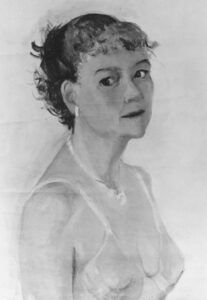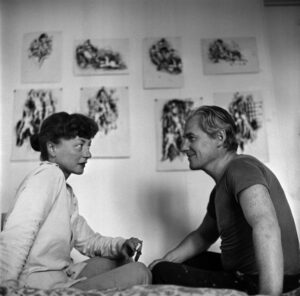Continua la collaborazione tra il liceo linguistico "Cattaneo-Dall'Aglio" e Redacon tramite la rubrica "Speakeasy" curata direttamente dagli studenti dell'anno scolastico 2020-2021.
****

Today we’ll talk about two artists overshadowed by their husbands: Josephine Nivison and Elaine de Kooning. These artists, despite being overshadowed and even mistreated, continued to work in the art world. Although they did not live a life of maximum fame they created extraordinary works and followed their passion. Here are their stories.
JOSEPHINE NIVISON:
Josephine Nivison, better known as Jo Hopper, was an American artist, who had been a successful painter for 15 years before her marriage to Edward Hopper, after which she was gradually forgotten. She was born in 1883 in Manhattan and from the beginning she showed a natural aptitude for art. This talent allowed her to attend the New York School of Art and, therefore, to keep in touch with this charming world.

Art didn’t make her earn enough money to survive, so, in February 1906, Josephine started her career as a public school teacher but she never dropped out of art, indeed, in 1914 during the Great War, she exhibited her paintings for the first time.Her fame grew every day more so that her works appeared in exhibitions alongside Man Ray, Modigliani and Picasso; in the catalogue her water colors were said to “add a gay note of color”.
In the summer of 1923, when she was 40 years old, Josephine met Edward Hopper in the artists’ colony of Gloucester, they struck up a friendship and worked side by side. He learnt a lot from Josephine: thanks to her suggestions, he began to work with water colors and also adopted her themes. During the same year, she was asked by the Brooklyn Museum to show six of her watercolor paintings and introduced Edward as an artist. The museum bought one of his paintings and, from this moment, he began his artistic career.

Edward and Josephine married in 1924, and, after that, their conflicts knew no bounds. Edward expected her to be a housewife but Jo wouldn’t give up to such a life; she was supposed to focus entirely on him and his incessant jealousy led him to rape her repeatedly. Jo continued to show her works under her own name but gave up her studio one year after the marriage, after she was forced to pose for him. He didn’t support her, quite the opposite: during expositions, he introduced her to gallerists and collectors as his wife, not as an artist, he never sent visitors up to her studio and most of them thought her to be an amateur. Josephine died on March 6, 1968.
Jo had been a tough cookie all her life but I think that her only huge mistake was her marriage to this terrible man. I refuse to call her Jo Hopper because Edward doesn’t deserve to be remembered and Josephine’s hard work must only be linked to her; only a brute could behave like that and oblige his wife to throw away her career without any good reason. She was forced to leave her friends, her job and her family only because of his jealousy and the worst part is that his career started thanks to her, is this supposed to be gratitude? I’m sick and tired of seeing that in history too many women had to deal with this kind of abuse, likewise it’s unacceptable that Jo had to throw away her life and dreams because of a toxic relationship.
ELAINE DE KOONING

Over the years, and over the course of history the role of women has never been considered equal to that of men. The result of this huge unfairness can still be identified nowadays, in situations where there are men who overshadow not only women, but also their worth and their jobs. Elaine Marie Catherine Fried (known as Elaine De Kooning) played an important role in the art world and she never gave up. Today's article is going to talk about a story full of “adventure”: her life.
Elaine De Kooning was born in 1918. Since she was a child, thanks to her mother, she got to know the world of art and visited many museums. In short, her great intelligence led her to travel a lot and to study in very important academies and universities where she could practice her painting skills. Elaine de Kooning expanded the realm of what is normally considered Abstract Expressionism with her lovely painted and dynamic portraits of friends, athletes, and even a President of the United States. She was a prolific artist, art critic, portraitist, and teacher during the height of the Abstract Expressionist era. Mixing abstraction and representation in much of her work, she took inspiration not only from those around her, but also from bullfights, sculpture, and cave paintings.
During her studies she got in touch with Willem De Kooning who was considered a great artist. Elaine thought he was in a class of his own. Throughout the years Elaine and Willem carried on a relationship and began to work together. Initially the two loved each other but their relationship went from bad to worse and became toxic: Willem started abusing and beating his wife, who soon found herself in a really difficult situation that led her to depression.The fact is, Willem ruined his wife’s life and, what is more, he forced his wife to be committed to a psychiatric hospital against her will. Elaine died alone in 1989 (at the age of 71) without saying goodbye to her husband.
It cannot be denied that during her career, Elaine De Kooning created wonderful paintings which were exhibited in many American museums (especially in Washington DC, at the National Portrait Gallery). One of her most famous paintings is called “John F. Kennedy” where the author represents the president of the United States. All things considered I've always appreciated the world of art and I've always noted that women were always overshadowed by men. I believe that also in the art world women should be equal to men. I personally hope that women will continue to fight for their rights and to achieve all their goals too.
(Ernesto Zambonini e Matilde Comastri, classe 4ªQ)
****
Oggi parleremo di due artiste oscurate dai loro mariti, Josephine Nivison e Elaine de Kooning. Queste artiste, pur essendo messe in ombra ed anche maltrattate, hanno continuato a lavorare nel mondo dell'arte. Anche se non hanno vissuto una vita di massima fama hanno creato opere straordinarie e hanno seguito la loro passione. Ecco le loro storie.
JOSEPHINE NIVISON
Josephine Nivison, meglio conosciuta come Jo Hopper, fu un'artista americana, che era stata una pittrice di successo per 15 anni, prima del suo matrimonio con Edward Hopper, dopo di che fu gradualmente dimenticata. Nata nel 1883 a Manhattan, mostrò fin dall'inizio una naturale attitudine all'arte. Questo talento le permise di frequentare la New York School of Art e, pertanto, restare in contatto con questo mondo affascinante.
L'arte non le fece guadagnare abbastanza soldi per sopravvivere, così, nel febbraio 1906, Josephine iniziò la sua carriera come insegnante di scuola pubblica, ma non abbandonò mai l'arte, anzi, nel 1914 durante la Grande Guerra, espose i suoi dipinti per la prima volta.La sua fama crebbe ogni giorno di più tanto che le sue opere apparirono in mostre accanto a quelle di Man Ray, Modigliani e Picasso; nel catalogo i suoi acquerelli si diceva "aggiungessero una nota allegra di colore".
Nell'estate del 1923, quando aveva 40 anni, Josephine incontrò Edward Hopper nella colonia di artisti di Gloucester, strinsero un'amicizia e lavorarono fianco a fianco.Edward imparò molto da Josephine: grazie ai suoi suggerimenti, iniziò a lavorare con gli acquarelli e adottò anche i suoi temi. Nello stesso anno, le fu chiesto dal Brooklyn Museum di esporre sei dei suoi dipinti ad acquerello e introdusse Edward come artista. Il museo acquistò uno dei suoi dipinti e, da questo momento, la sua carriera artistica iniziò.
Edward e Josephine si sposarono nel 1924, dopo di che i conflitti non ebbero limiti. Edward si aspettava che lei fosse una casalinga, ma Jo si rifiutò; lei doveva concentrarsi interamente su di lui e la sua incessante gelosia lo portò a violentarla ripetutamente. Jo continuò a esporre le sue opere con il proprio nome, ma lasciò il suo studio un anno dopo il matrimonio, dopo che fu costretta a posare per lui. Il marito non la sostenne, anzi: durante le esposizioni, la presentò a galleristi e collezionisti come sua moglie, non come artista, non inviò mai visitatori nel suo studio e la maggior parte di loro la riteneva una dilettante. Josephine morì il 6 marzo 1968.
Jo fu una donna dalla forte personalità per tutta la vita, ma credo che il suo unico errore sia stato il matrimonio con quest'uomo terribile. Mi rifiuto di chiamarla Jo Hopper perché Edward non merita di essere ricordato e il duro lavoro di Josephine deve essere legato solo a lei; solo un bruto potrebbe comportarsi così e obbligare sua moglie a buttare via la sua carriera senza alcuna buona ragione. Lei fu costretta a lasciare i suoi amici, il suo lavoro e la sua famiglia solo a causa della gelosia del marito e la parte peggiore è che la carriera di quest’ultimo iniziò grazie a lei, questa dovrebbe essere gratitudine? Sono stanca di vedere che nella storia troppe donne hanno dovuto affrontare questi abusi, allo stesso modo è inaccettabile che Jo abbia dovuto buttare via la sua vita e i suoi sogni a causa di una relazione tossica.
ELAINE DE KOONING
Nel corso degli anni e della storia, il ruolo delle donne non è mai stato considerato pari a quello degli uomini. Il risultato di questa grande ingiustizia può essere visto ancora oggi in situazioni dove uomini non solo mettono in ombra la propria moglie, ma anche i lavori di quest’ultima. Elaine Marie Catherine Fried, conosciuta come Elaine de Kooning giocò un ruolo importante nel mondo dell’arte e non si arrese mai. Questo articolo parlerà di una storia piena di avventure: la sua vita.
Elaine de Kooning nacque nel 1918. Sin da quando era bambina, grazie a sua madre, conobbe il mondo dell’arte e visitò molti musei. In breve, la sua grande intelligenza la portò a viaggiare molto e a studiare in accademie e università molto importanti dove poteva praticare le sue abilità pittoriche. Elaine de Kooning ampliò il regno di quello che è normalmente considerato l'espressionismo astratto con i suoi bellissimi ritratti dinamici di amici, atleti e persino di un presidente degli Stati Uniti. Fu un'artista prolifica, critica d'arte, ritrattista e insegnante durante il culmine dell'era “espressionista astratta”. Mescolando astrazione e rappresentazione in gran parte del suo lavoro, prese ispirazione non solo da coloro che la circondavano, ma anche da corride, sculture e pitture rupestri.
Durante i suoi studi conobbe Willem De Kooning, che era considerato un grande artista. Elaine lo considerava di una classe a parte per la sua bravura. Nel corso degli anni Elaine e Willem portarono avanti una relazione e iniziarono a lavorare insieme. Inizialmente i due si amavano ma la loro relazione andò di male in peggio e diventò tossica: Willem iniziò ad abusare e picchiare sua moglie, che presto si trovò in una situazione davvero difficile che la portò alla depressione. Il fatto è che Willem rovinò la vita di sua moglie e, inoltre, la costrinse ad essere ricoverata in un ospedale psichiatrico contro la sua volontà. Elaine morì da sola nel 1989 (all'età di 71 anni) senza nemmeno salutare il marito.
Non si può negare che durante la sua carriera, Elaine De Kooning abbia composto meravigliosi dipinti che sono stati esposti in molti musei americani (soprattutto a Washington DC, alla National Portrait Gallery). Uno dei suoi dipinti più famosi è intitolato "John F. Kennedy" dove l'autore rappresenta il presidente degli Stati Uniti. Tutto sommato ho sempre apprezzato il mondo dell'arte e ho sempre notato che le donne sono sempre state messe in ombra dagli uomini. Credo che anche nel mondo dell'arte le donne debbano essere uguali agli uomini. Personalmente spero che le donne continuino a lottare per i loro diritti e anche per i loro valori.
(Ernesto Zambonini e Matilde Comastri,classe 4ªQ)







